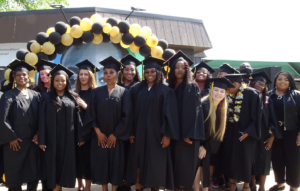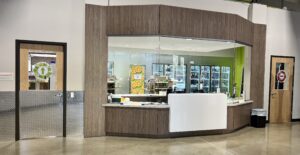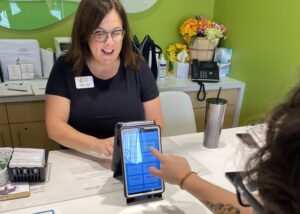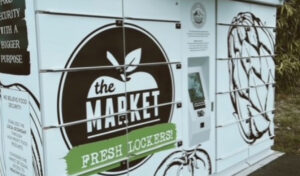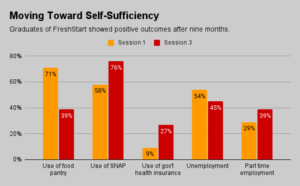When Open Cupboard in Minnesota opened the doors of its new grocery-store style food pantry last year, the team planned to serve no more than 100 shoppers a day.
Instead, they were quickly “drinking from the fire hose trying to keep up,” Executive Director Jessica Francis recalled. They opened a second location in March and now serve about 700 shoppers each day between the two locations. That’s more than double the number of people they used to serve when the organization was known as the Christian Cupboard Emergency Food Shelf.
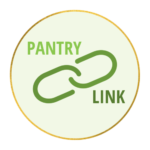
The two new storefronts, called Today’s Harvest, add to the drive-through and mobile services that Open Cupboard continues to offer, and feature essentials like dairy, meat and produce from food rescue partnerships and food bank donations. The success of the model is proof of a longstanding hunch among staff of the 40-year-old pantry — that barriers to access had kept many families from seeking help.
“We were blown away by how many people came for the food when we changed the way we talked about it,” Francis said. “Many people were willing to come when the stigma wasn’t attached.”
What makes shopping at Today’s Harvest different from the pantry’s traditional food distributions is that anyone can grab a shopping cart and walk into the bright market, peruse the refrigerator cases and produce bins for items they want, and walk out without having to enroll in a program or provide proof of qualification.
The shops — which are deliberately not called pantries or food shelves — are open six days a week for six hour stretches most days, eliminating the need to line up at a specific time to get food. And when shoppers have made their selections, they “check out” by answering a few questions on an iPad, but they don’t have to provide their name. They are welcome to return the next day.
The cost of this “high access, low barrier” model, as Francis put it, is that the stores cannot serve any food from the U.S. Department of Agriculture’s The Emergency Food Assistance Program (TEFAP), which does require documentation about the individuals being served and limits the frequency with which they can receive aid.

The idea for the Today’s Harvest storefronts took root during the early days of the pandemic when many people called with concerns about whether they qualified for government assistance. That’s when the Open Cupboard staff realized that a no-questions-asked model for distributing food might help them reach more people in need.
“When funding became available, we tried to figure out how to better serve the community,” Francis said. “We decided there will be no barriers to cross to be able to get the food.”
Francis and her team stock the stores with the top five items that their clients prefer, including fruits and vegetables, dairy and meat. They try to purchase culturally specific items such as fish sauce for their Hmong customers and halal meat for the area’s large Somali community to the extent that their budget allows.
The organization is planning to expand its diversity outreach efforts this year, such as through a partnership with an East African community group, to serve communities with high rates of hunger that may not be receiving food because of barriers such as transportation or language.
Keeping the stores stocked requires creative sourcing of food. Staples like potatoes and onions come from food banks, and rescued food from groceries offers variety such as avocados and green bell peppers.
“I don’t think that this model would work as well if it was exclusively food rescue from grocery stores,” Francis said.
Open Cupboard hopes to open more Today’s Harvest shops around the St. Paul-Minneapolis area and is using what it’s learning from the stores to reduce barriers in its more traditional mobile and drive-through food distributions — such as possibly holding paperwork and questions until after a person has received food.
“When you put the gate up first, that psychologically changes the whole conversation,” Francis said. Her team is also creating a toolkit to share its learnings with other pantries that might want to try the model. “We’re learning a lot about barriers and access.”
Ambreen Ali is a freelance journalist and the founder of Central Desi, a newsletter about New Jersey’s South Asian community.
CAPTION ABOVE: Open shelving at one of Open Cupboard’s “Today’s Harvest” storefronts.
Like what you’re reading?
Support Food Bank News
This article was made possible by the readers who support Food Bank News, a national, editorially independent, nonprofit media organization. Food Bank News is not funded by any government agencies, nor is it part of a larger association or corporation. Your support helps ensure our continued solutions-oriented coverage of best practices in hunger relief. Thank you!
Connect with Us:

